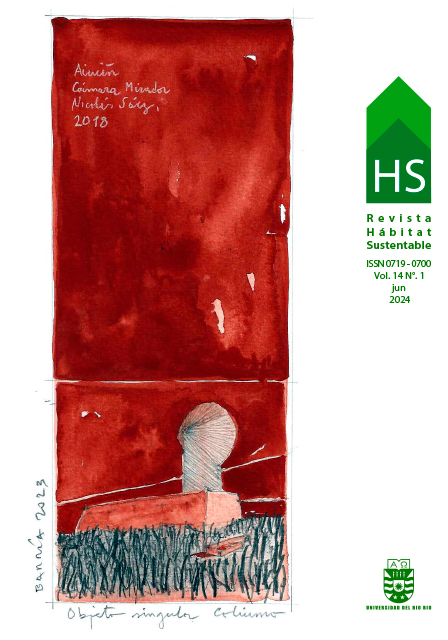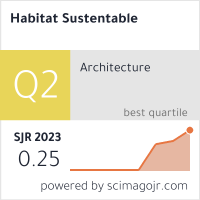Recognizing light and thermal behavior in the structure and functionality of Baber-rooms in the vernacular buildings of Bandar Lengeh
DOI:
https://doi.org/10.22320/07190700.2024.14.01.08Palabras clave:
ligera, comportamiento térmico, cazador de viento Baber, clima, Bandar LenguéResumen
Bandar-Lengeh is located in a region with a hot and humid climate in the south of Iran. As a result, given its harsh weather conditions, several elements and spaces have been devised to create a special kind of sustainable architecture, a Baber-Room. Since there is no evidence of any scientific study regarding Baber-Rooms or their analysis, this research has been conducted in two parts, structural and functional, to better understand them as a stable structure. To examine these, an area of Bandar-Lengeh was chosen (36 houses aged 70 or above) for a qualitative (introducing the Baber-Room, its components, materials, and construction process, the occupied areas, orientation, and positioning) and a quantitative study (light-measurement using Ecotect analysis software and temperature measurements with a “Fluke T3000fc” device). This was done at a time when mechanical air-conditioners were not standard, to see whether these rooms could meet the needs of inhabitants as natural air-conditioners.
Descargas
Citas
AHMAD, A., OM, P., ANIL K., HASNAIN, S. M. M., VERMA, P., ZARE, A., DWIVEDI, G., & PANDEY A. (2022). Dynamic analysis of daylight factor, thermal comfort and energy performance under clear sky conditions for building: An experimental validation. Materials Science for Energy Technologies, 5, 52-65. https://doi.org/10.1016/j.mset.2021.11.003
AL-SAGGAF, A., NASIR, H., & TAHA, M. (2020). Quantitative approach for evaluating the building design features impact on cooling energy consumption in hot climates. Energy and Buildings, 211, 109802. https://doi.org/10.1016/j.enbuild.2020.109802
BABAEI, M., SOLTANZADEH, H., & ISLAMI, S. Y. (2013). A study of the lighting behaviour of Moshabak in Kashan's houses with emphasis on the notion of transparency. Architectural Science Review, 56(2), 152-167. https://doi.org/10.1080/00038628.2012.729309
BAHERETIBEB, Y., & WHITEHEAD, C. (2024). It takes a village to raise a child,” university teachers’ views on traditional education, modern education, and future I integration in Ethiopia. Frontiers in Education, Frontiers Media SA. https://doi.org/10.3389/feduc.2024.1348377
BARZEGAR, Z., & SAJJADI, K. (2023). Analogy of thermal comfort with the influence of openings by PMV method in traditional houses and apartments in Shiraz. Journal of Iranian Architecture & Urbanism (JIAU), 14(1), 117-131. https://doi.org/10.30475/isau.2023.231996.1424
DWIJENDRA, N. K. A., & ADHIKA, I. M. (2022). The Resilience of Undagi's Role in Traditional Balinese Architecture Based on Asta Kosala Kosali in Bali, Indonesia. Res Militaris, 12(6): 1099-1113.
FORUZANMEHR, A. (2015). People's perception of the loggia: A vernacular passive cooling system in Iranian architecture. Sustainable cities and society, 19, 61-67. https://doi.org/10.1016/j.scs.2015.07.002
GUPTA, J., CHAKRABORTY, M., RALLAPALLI, H. S., & NEVIDHITHA, R. (2020). Climate-Responsive Architecture in Rural Vernacular Dwellings: A Study in Composite Climate in Ranchi, Jharkhand, India. AEGAEUM Journal, 8(7).
JARADAT, H., ALSHBOUL, O. A. M., OBEIDAT, I. M., & ZOUBI, M. K. (2024). Green building, carbon emission, and environmental sustainability of construction industry in Jordan: Awareness, actions and barriers. Ain Shams Engineering Journal, 15(2), 102441. https://doi.org/10.1016/j.asej.2023.102441
LI, J., ZHAI, Z., LI, H., DING, Y., & CHEN, S. (2024). Climate change's effects on the amount of energy used for cooling in hot, humid office buildings and the solutions. Journal of Cleaner Production, 442, 140967. https://doi.org/10.1016/j.jclepro.2024.1409
LISA, N. P., ZURAIHAN, Z., FERNAND, R., & SISKA, D. (2021, April). Estimation of energy consumption efficiency in office rooms cooling systems to create thermal comfort for the user. In IOP Conference Series: Earth and Environmental Science (Vol. 738, No. 1, p. 012016). IOP Publishing.
MATZARAKIS, A., MAYER, H., & IZIOMON, M. G. (1999). Applications of a universal thermal index: physiological equivalent temperature. International journal of biometeorology, 43, 76-84. https://doi.org/10.1007/s004840050119
MAZRAEH, H. M., & PAZHOUHANFAR, M. (2018). Effects of vernacular architecture structure on urban sustainability case study: Qeshm Island, Iran. Frontiers of architectural research, 7(1): 11-24. https://doi.org/10.1016/j.foar.2017.06.006
MAZRAEH, H. M., & PAZHOUHANFAR, M. (2020). Functionalism of wind renewable energy in vernacular elements of wind catcher and Moshabak (Case Study: Quesh Island). Journal of Urban & Environmental Engineering, 14(1). https://periodicos.ufpb.br/ojs/index.php/juee/article/view/51925/30532
MOHAMMADI MAZRAEH, H. (2021). Position of Entrance in the Architecture of Vernacular Buildings of Bandar-Lengeh. Journal of Urban Development and Architecture-Environment Identity (JUDA-EI), 2(6): 21-39. https://www.armanshahrjournal.com/article_80507_c10c85bd9676bec9be9e5b07ea2bc694.pdf
MOHAMMADI MAZRAEH, H. (2022). The Role of the Function of Semi-Open Space in the Structure and Architecture of the Native Buildings of Bandar-Lengeh. Journal of Urban Ecology Researches 13(Series 27), 1-18. https://doi.org/10.30473/grup.2022.58150.2607
MOHAMMADI MAZRAEH, H. (2023). Recognition of Designs and Motifs of Architectural Windcatchers and Openings Native to City of Bastak. Journal of Iranian Handicrafts Studies, 5(2), 115-128. https://doi.org/10.22052/HSI.2022.246448.1026
NEMAT GORGANI, O. (2002). Light Background in Architecture and Lighting Fixtures in Iran Islamic Art, Asar.
NEUFERT, E., & NEUFERT, P. (2012). Architects' Data, John Wiley & Sons.
PHILOKYPROU, M., & MICHAEL, A. (2021). Environmental sustainability in the conservation of vernacular architecture. The case of rural and urban traditional settlements in Cyprus. International Journal of Architectural Heritage, 15(11), 1741-1763. https://doi.org/10.1080/15583058.2020.1719235
PUTRI, A. K., & SUNESTI, Y. (2021). Sharia branding in housing context: A study of halal lifestyle representation. Journal Sosiologi Walisongo, 5(1): 77-92. https://doi.org/10.21580/jsw.2021.5.1.7268
RATREE, S. M., FARAH, N., & SHADAT, S. (2020, June). Vernacular Architecture of South Asia: Exploring Passive Design Strategies of Traditional Houses in Warm Humid Climate of Bangladesh and Sri Lanka. In Proceedings of the International Conference of Contemporary Affairs in Architecture and Urbanism-ICCAUA (Vol. 3, No. 1, pp. 216-226).
RAZAVIAN, F., ALEMI, B., KAMALI ZARCHI, S., & TAFRESHI, F. (2023). Studying and Proposing an Energy-efficient Residential Design for Kashan with a Hot and Dry Climate. Journal of Solar Energy Research, 8(2), 1559-1573. https://jser.ut.ac.ir/article_92582.html#:~:text=10.22059/JSER.2023.354267.1273
ROSHAN, G., YOUSEFI, R., KOVÁCS, A., & MATZARAKIS, A. (2018). A comprehensive analysis of physiologically equivalent temperature changes of Iranian selected stations for the last half century. Theoretical and applied climatology, 131, 19-41. https://doi.org/10.1007/s00704-016-1950-3
SALAMI, B. A., ABBA, S. I., ADEWUMI, A. A., DODO, U. A., OTUKOGBE, G. K., & OYEDELE, L. O. (2023). Building energy loads prediction using bayesian-based metaheuristic optimized-explainable tree-based model. Case Studies in Construction Materials, 19, e02676. https://doi.org/10.1016/j.cscm.2023.e02676
SARGAZI, M. A. (2023). The Effect of Natural Materials-Based Climate Adaptation Techniques on Thermal Comfort in the Vernacular Architecture of Sistan, Iran. Iranian Journal of Archaeological Studies, 13(2). https://ijas.usb.ac.ir/article_8042.html
SONAWANE, M., & VAKHARIA, A. B. (2023). Comparative Analysis of Thermal-performance of vernacular dwelling in Arid climate of India. International Journal of Technology Engineering Arts Mathematics Science, (1), 403-408. https://aissmsioitresearch.com/wp-content/uploads/2023/12/SB_IJTEAMS_61.pdf
TOROXEL, J. L., & MONTEIRO SILVA, S. (2024) A Review of Passive Solar Heating and Cooling Technologies Based on Bioclimatic and Vernacular Architecture. Energies 17(5), 1006. https://www.mdpi.com/1996-1073/17/5/1006
XU, F., & LIU, Q. (2023). Building energy consumption optimization method based on convolutional neural network and BIM. Alexandria Engineering Journal, 77, 407-417. https://doi.org/10.1016/j.aej.2023.06.084
Descargas
Publicado
Cómo citar
Número
Sección
Licencia
Derechos de autor 2024 Hamed Mohammadi-Mazraeh, Mohammadreza Mahmoudzadeh

Esta obra está bajo una licencia internacional Creative Commons Atribución-CompartirIgual 4.0.
El contenido de los artículos que se publican en cada número de Hábitat Sustentable, es responsabilidad exclusiva de los autores y no representan necesariamente el pensamiento ni comprometen la opinión de la Universidad del Bío-Bío.
Los autores/as conservarán sus derechos de autor y garantizarán a la revista el derecho de primera publicación de su obra, el cuál estará simultáneamente sujeto a la Licencia de Reconocimiento de Creative Commons CC BY-SA que permite a otros compartir-copiar, transformar o crear nuevo material a partir de esta obra con fines no comerciales, siempre y cuando se reconozcan la autoría y la primera publicación en esta revista, y sus nuevas creaciones estén bajo una licencia con los mismos términos.











 Programa de Información Científica/Concurso Fondos de Publicación de Revistas Científicas 2018/ Proyecto Mejoramiento de Visibilidad de Revistas UBB (Código:FP180007)
Programa de Información Científica/Concurso Fondos de Publicación de Revistas Científicas 2018/ Proyecto Mejoramiento de Visibilidad de Revistas UBB (Código:FP180007) 





